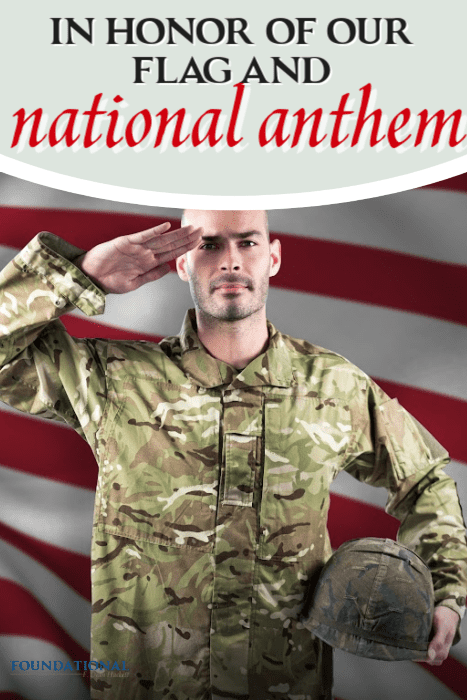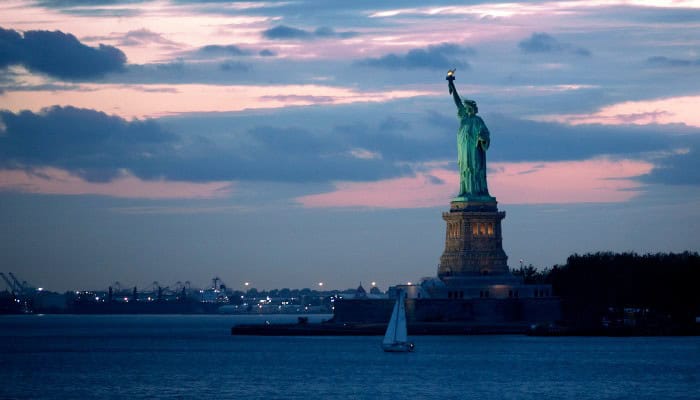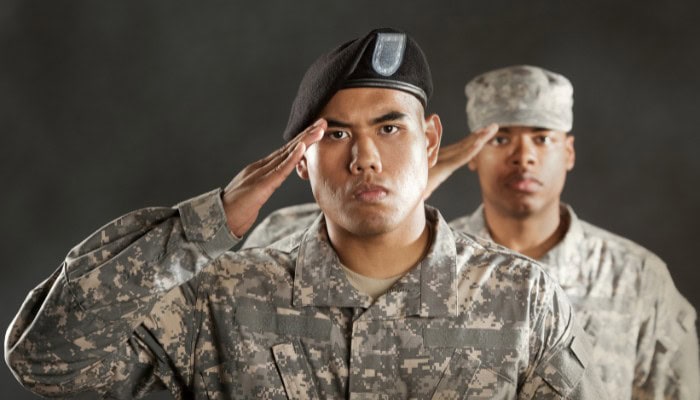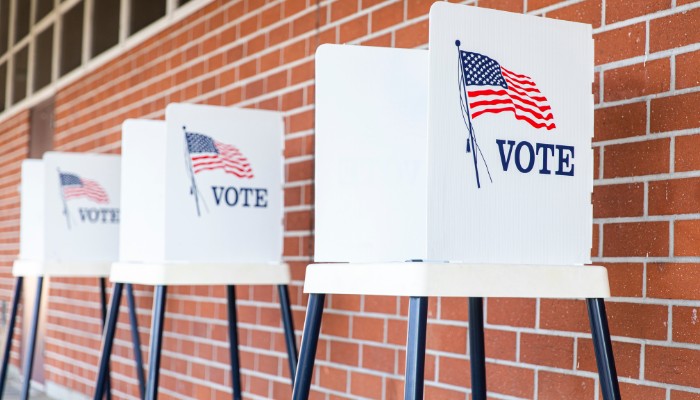In Honor of Our Flag and the National Anthem
I hope you love the products and resources I recommend here at Foundational. It is possible that I get a commission and collect income from the links on this page. Click here for more info.
February 19, 1945 a major battle in the Pacific was launched by the Fifth Marine Amphibious Corp, the Fourth Marine Division and the 133rd Naval Construction Battalion.
It was an amphibious attack on the Island of Iwo Jima. The goal was to capture the island and the three air fields from the Japanese forces and make it a staging area for the invasion of Japan, itself.
The Imperial forces of Japan had massively fortified the island to protect those air fields. There were eleven miles of tunnels, heavily fortified defense networks, hidden artillery bunkers and 21, 060 Japanese soldiers.
Five awful, bloody weeks of close combat ensued with the landing on the beaches.
Time-Life correspondent, Robert Sherrod described the conflict of the landing as “a nightmare in hell.”
At the end of the first day, 30,000 Marines had landed and 40,000 more were on their way. But it was literally taking the Island foot by foot and at times it seemed inch by inch.
The fifteen foot steep black ash slopes combined with the hidden artillery bunkers and ambush attacks that sprang out of the tunnels, made the warfare fierce and many times literally hand to hand.
The Island of Iwo Jima was officially declared secure thirty-five days later at 09:00 on March 26, 1945, following a severe ninety minute battle at the Japanese command post. Only 216 of the 21, 060 Imperial forces survived the battle of Iwo Jima. 6,821 US forces were lost and 19,217 were wounded.
One fourth of all the Marines receiving the Medal of Honor in WWII were earned in that battle on Iwo Jima.
The victory of Iwo Jima has been immortalized by Joe Rosenthal of the Associated Press, with his picture taken of six United States Marines raising The American Flag on Mount Suribachi, February 23, 1945, just five days after the battle had begun and one month before the island was officially declared secured.
But 130 years before the raising of Old Glory on Suribachi, The Red, White and Blue withstood a different withering attack.
It was September 13, 1814. The United States was in the second year of a war to yet again defend her freedom and liberties as a sovereign nation against the mighty power of Great Britain.
The British had bombed the United States Capitol, burned the President’s House, the Treasury building, and the Navy yard.
They held several American prisoners on board ships throughout the British Empire. Thirty-five year old attorney, son of a distinguished judge, Francis Scott Key, had a close friend being held as a prisoner of war on board one of the ships that had attacked and burned our nation’s capital city.
He was sixty-five year old Dr. William Beanes.
Key had been given permission from President James Madison to seek negotiations with the British for a possible prisoner exchange.
The British armada was moving out of the Chesapeake after their withering attack on Washington DC and were sailing to Baltimore, Maryland, and Fort McHenry.
The Flag ship was hailed by Mr. Key and Colonel John Skinner.
They were allowed to board and immediately learned that Dr. Beanes was scheduled to be hung. After much negotiation they were able to persuade the British to make the prisoner exchange and Dr. Beanes was released.
However, Mr. Key, Colonel Skinner, and Dr. Beanes and the crew of their skiff were not allowed to return to shore.
Their skiff was tied to the British Flag Ship and they were held under guard by several marines on board their own skiff. They were then towed to the point of attack on Fort McHenry. The British Commander was determined they would not return home until Fort McHenry and Baltimore were burned like Washington D.C.
There was an armada of 50 British war ships moving into position two miles off the coast.
Five of the most powerful ships in the British navy were among them. Anticipating the coming attack, the leaders of Baltimore and the military commanders had prepared themselves well for the siege.
A new 32 pound cannon battery was placed at Fort McHenry, along the water’s edge. They built new and stronger cannon batteries along the Patapsco River and barges were constructed to restrict passage on the river.
Preparations were also made to stop a possible British ground force invasion.
In the eyes of the new Commander at Fort McHenry, Major George Armistead, the preparations were not complete. He ordered a new flag to be made for the fort. He wanted the flag to be large enough the British would have no difficultly seeing if from a great distance at sea. Mary Pickersgill, a widow and an experienced flag maker, was selected.
She made a woolen flag 42 feet in length and 30 feet wide.
The new flew was mounted on a 90-foot pole located in a position making it visible to all the surrounding area. The huge ensign at Fort Henry was not only a defiant signal to the British Commander and the armada. It would also be the signal that Fort McHenry had surrendered by it being lowered.
Sunrise, Tuesday morning, September 13th, the bombardment commenced. All day long the canons bellowed at horrifying rate of more than one shell every minute. A torrential rain began falling around noon time, and yet the barrage continued. Key wrote,
“It seemed as though mother earth had opened and was vomiting shot and shell in a sheet of fire and brimstone.”[1]
Read more: http://www.smithsonianmag.com/history/francis-scott-key-the-reluctant-patriot-180937178/#kbEe7AXWYXBUrQb5.99
Give the gift of Smithsonian magazine for only $12! http://bit.ly/1cGUiGv
Follow us: @SmithsonianMag on Twitter
As night fell, the bombardment eased and the men in the skiff begged to know, “Is the flag still there?” The answer came, “Yes, it still waves.”
A small armada of British vessels had moved in closer during the lull in the fighting. The Americans spotted the movement and released a massive cannonade driving them back out of range.
Infuriated by the counter attack, the British Commander ordered a redoubling of the bombardment.
As the night hours deepened and the horrifying sounds pounded the air, the red glow of the rockets and shells lighting the dark skies, made it possible for Mr. Key to occasionally see a glimpse of the flag and he assured the men in the skiff, the fort had not surrendered.
The Americans were now in deep prayer for the courage of the American soldiers and the steadfastness of their young nation.
Early Wednesday morning, around 4:00 AM the shelling stopped. Great concern gripped the hearts of the American men on the skiff. Were the guns silent because the fort had surrendered? As the sun was burning the morning haze from the water, a very anxious Francis Scott Key, began looking through the spy glass although it was way too early to see clearly.
But, he had to know. Was it the Union Jack flying over the fort or was it “The Stars and Stripes?”
As he continued his search through the dawning sky, at last there was just enough light he could barely see a flag flying. He looked hard through the glass. As he continued his vigil, sight became clearer.
It was the red and white stripes and the blue field with stars flying over Fort McHenry.
She was severely tattered and torn by the cannonade. Old Glory was still flying. The joy was overwhelming!!
As the early dawn of morning had come on September 14th, the pouring rain stopped, and the British Commander realized his attack of Fort McHenry was not to be successful. As the British fleet began to move away, the skiff carrying the Americans was untethered from the Flag Ship and the prisoner exchange was finally completed.
During the long twenty-five hours of the harrowing bombardment Key had begun writing his thoughts and emotions on the back of a letter.
“Oh say, can you see; by the dawns early light; what so proudly we haled at the twilight’s last gleaming; whose broad stripes and bright stars, through the perilous fight, at the ramparts we watched we… streaming”
After arriving at shore and in his hotel room, Francis Scott Key sat at a writing desk and completed the composition that was filling his heart.
“…and the rocket’s red glare, the bombs bursting air; gave proof through the night that our flag was still there. O say, does that star-spangled banner yet wave, o’er the land of the free and the home of the brave.”
General George Armistead reported later in a letter to Secretary of War, James Monroe, fifteen hundred to eighteen hundred shells had fallen on Fort McHenry over the twenty-five hours of siege.
America does not have a king or queen that symbolizes our nation. Nor do we have a throne or a palace that declares the great strength of this nation.
That is why our Founding Fathers built a spacious but simple home for our Presidents; originally named the President’s House but after it was rebuilt from the fire of 1814 it has been known as the “White House.”
What we do have is the American Flag that represents our nation’s honor and greatness; and declares the liberty of her Declaration of Independence; and proclaims the authority and freedoms of her Constitution.
That is why a soldier will not let her fall to the ground and will defend her to his death.
That is why the coffin of our brave men and women is draped in the Colors, then it is carefully folded and presented to family with the words, “On behalf of the President of the United States, and their branch of service, and a grateful nation, please accept this flag, as a symbol of our appreciation for your loved one’s honorable and faithful service.”
The “Star-Spangled Banner,” our National Anthem, is the declaration of our love, devotion, honor and respect for this precious and dear land.
Oh, the United States is not without flaw.
Our history is not without mistakes. We are not currently without blemishes. But the United States of America is still the nation with the greatest liberties. It is the largest melting pot of free humanity in the history of mankind.
So we sing with a grateful heart for the men and women who have purchased these liberties and protected this Constitution. We raise our voice with tears in our eyes, though barely able to reach the notes,
We stand at attention, and we raise our salute, and proudly proclaim: “I pledge allegiance to the flag of the United States of America; and to the Republic for which it stands; one nation, under God, in divisible, with liberty and justice for all.”
For more than two centuries, desperate men, women, boys and girls, living under the heel of a despot, strangled by the domination and intimidation of a Marxist regime, or living behind the invisible bars of the bamboo and the iron curtains, have looked to our flag with hope and heard the words of our national anthem with belief in her liberty.
We must never allow Antifa, anarchy, or narcissistic rebellion to silence our song or take down our flag. We must never allow socialist, Marxist, ideology to strangle our freedoms or silence our declaration, “With liberty and justice for all.”
Brothers and sisters in arms, you have given so much and sacrificed so much, defending this nation, honoring her flag, and living out the words of her national anthem.
Thank you for your brave service to our nation and for protecting our flag.
Thank you, Almighty God for the United States of America. God, please bless America.
May our flag wave free and our anthem resound loudly and with honor and respect!
God bless each of you and your families!!
More Article for Veteran’s Day







